Norman Lacy
| The Honourable Norman Lacy Th.Schol. Australian College of Theology, B.A.(Hons) Monash University Australia, M.Sc. (Dunelm) Durham University U.K. | |
|---|---|
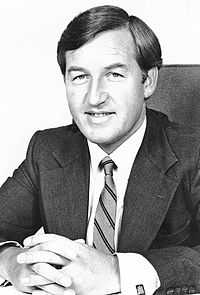 | |
| Member of Parliament for Warrandyte | |
| In office 1973–1982 | |
| Preceded by | James Manson |
| Succeeded by | Louis Hill |
| Minister for the Arts | |
| In office 1979–1982 | |
| Preceded by | Rupert Hamer |
| Succeeded by | Race Mathews |
| Assistant Minister of Education | |
| In office 1979–1980 | |
| Preceded by | Alan Scanlon |
| Minister of Educational Services | |
| In office 1980–1982 | |
| Succeeded by | Robert Fordham |
| Personal details | |
| Born | 25 October 1941 Richmond, Victoria |
| Political party | Liberal Party of Australia |
| Residence | Wye River, Victoria |
| Alma mater | Durham University U.K. |
| Occupation | Retired |
| Religion | Anglican |
Norman Henry Lacy, Australian politician, is a former Victorian Government Minister from May 1979 to April 1982 who grew up in Richmond, Victoria and three times represented his state at national under age basketball championships. He completed university degrees in theology, sociology and management science and had a diverse career that included periods as an apprenticed plumber, an Anglican priest, a liberal parliamentarian, a management educator and an information technology industry executive. He has been President of Independent Contractors Australia[1] since October 2008 and lives in Wye River, Victoria.
As Minister for the Arts from 1979-82 he was responsible for the construction of the Victorian Arts Centre (and the design of its management structure), the establishment of the Australian Children's Television Foundation, the creation of Film Victoria and the reconstitution of the Victorian College of the Arts. As Assistant Minister of Education and Minister of Educational Services from 1979-82 he was responsible for reforming the administration of the Education Department of Victoria; for establishing the Special Assistance Program to address illiteracy and innumeracy in primary schools; for introducing a reformed Health and Human Relations Education curriculum and compulsory Physical Education in government schools.
Early Life (1941-1956)

During his childhood and teenage years he lived with his parents and siblings, initially at 31 Buckingham Street (for 6 months), and then at 89 Church Street, North Richmond. As an infant he attended the Boroondara Kindergarten in Nth Richmond. His primary education took place at North Richmond State School (now Yarra Primary School) and his secondary education (1954–56) and apprenticeship training at Richmond Technical College (1957–59) and the Royal Melbourne Institute of Technology (1960).
The family belonged to St Matthias Church of England in Church Street, North Richmond (since demolished) where Norman Lacy was confirmed on 19 July 1953. The family were also active in the Scout and Guide movement in Richmond. His mother was the Principal Guider for the Girl Guide movement with oversight of the guide companies in the Richmond district. She was also a member of the Trefold Guild. His father was Assistant Secretary of the Richmond Union Bowling Club.
Victorian Basketballer (1956-1960)

Norman Lacy's mother died of lung cancer on 21 February 1956 at the age of 44 when he was 14 years of age. Lacy regarded this event as the most formative of his life.[2]
He dealt with his grief by throwing himself into sport. The opportunity to play for his local church basketball team in the Church of England Basketball Association competition presented itself and he devoted all his spare time to the sport. During his teenage years, Lacy three times represented Victoria at the Australian Junior Basketball Championships, as under 16 team Captain in Adelaide in 1956, as under 18 team Vice-Captain in Sydney in 1957, and again in Davenport in 1958, in which year he also won the Best and Fairest Player award.
Lacy's initial occupation from 1957 to 1961 was as an apprenticed plumber and gasfitter in his father's plumbing business that traded under the name A.H.Lacy Bros. in Richmond.
Strongly influenced by the Billy Graham crusade in Melbourne in 1959, Lacy became a committed evangelical Christian. During his early 20s he was a member of the Scripture Union and Children's Special Service Mission movements and as a clergyman, the Anglican Evangelical Fellowship of Australia. He subsequently, became an active advocate of the application of Christian teaching to social issues. This is reflected in his first (maiden) speech in the Victorian Parliament where he argued for the responsibilities parliamentarians had for ensuring that the poor had appropriate opportunities of breaking out of the culture of poverty.
His father died at the age of 52 on 30 May 1960 when Lacy was 18 years of age. His father had experienced poor health for many years with heart and kidney conditions and had never fully recovered from his wife's death four years earlier, struggling with the impact this had on his young family. For Lacy this represented a seminal moment in his life. He came to acutely feel that he was alone in the world and that whatever the future held, it would be determined by his efforts alone.
Anglican Priest (1960-1973)

Lacy married his first wife in August 1965 with whom he had three daughters.
From 1964 to 1973, Lacy served as Curate in the parishes St Mary's Caulfield (1964 to 1966) and St Stephen's Richmond (1966–1968). And then as Vicar of St John's Healesville with Yarra Glen and Christmas Hills (1968–1973).[5] Lacy's interest in education policy was fostered in Healesville through the relationship he established with the parents and teaching staff at the Healesville High School. He devoted two days each week teaching religious education to each class at the school becoming, in effect, its honorary chaplain. He added to this integration into the school's life by becoming a member of the school's Parents and Friends Association and for some time its honorary secretary.
While at Healesville, Lacy completed his study (commenced at Ridley) for the degree Scholar in Theology (Th Schol.) in 1969 and graduated the following year. In 1970, as a mature age student, he studied for and completed the Higher School Certificate, the prerequisite for his entry into the Arts Faculty at Monash University to which he and his wife travelled twice each week to study part-time for their Arts (Hons) degrees.
Early in his incumbency at Healesville, Lacy joined the Liberal Party of Australia under the influence, and with the support of, some prominent Liberal parliamentarians who were amongst his parishioners such as Peter Howson, Vasey Houghton, Russell Stokes and Gracia Baylor. Other Liberals such as Vernon Hauser and Jim Manson were active in ensuring that he secured the party's pre-selection for the seat of Ringwood in the Parliament of Victoria for the State election in May 1973. As a result of legislation introduced by Premier Henry Bolte prior to the 1970 Victorian election that removed the prohibition on ministers of religion from being elected to the Victorian Parliament (along with criminals and bankrupts), Norman Lacy became the first clergyman to be elected to the Victorian Parliament. In 1979, he became the only clergyman ever to be appointed a Minister of the Crown in Victoria.
After winning the seat of Ringwood in the Legislative Assembly in May 1973, Lacy moved his young family from the Vicarage in Healesville to a home they established in his electorate at 39 Alice Street, North Croydon and continued to live there for the nine years that he was a member of the Victorian Parliament. During this period, his children attended Croydon Primary School and Tintern Church of England Girls Grammar School. The family belonged to St John's Anglican Church in Croydon.
Liberal Parliamentarian (1973-1982)
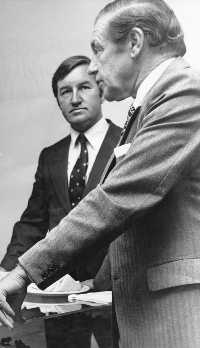
Lacy was on the Victorian Parliament's Qualifications Committee in 1973 and 1974.[5] It was on this committee that Lacy got to work with the Opposition Leader Clyde Holding who often reminded Lacy that for a building trade apprentice from Richmond (the electorate Holding represented) he was in the wrong party. Lacy returned the banter in numerous parliamentary debates in which he took on Holding and his party over the growing level of unemployment that was emerging in the Australian economy under the Whitlam government.
From the time that he joined the party in 1972, Lacy was an active and vocal 'small l' Liberal and a strong supporter of the leadership of Rupert Hamer. He publicly supported Hamer and many of his causes. In particular, he was active in his support for Hamer's private member's Bill for the abolition of capital punishment in Victoria. Lacy made what many regarded as the finest parliamentary speech of his career on the Bill in which he made much use of his theological training. As a result, he made a number of friends amongst the Labor opposition including fellow Anglican and Education spokesman Robert Fordham and Barry Jones who for many years had led the abolitionist campaign on this issue. He also became the unofficial 'numbers man' on the Government side of the Legislative Assembly where support for the Bill was hard to come by. In this he was assisted by his close friend Peter Block[6] who undertook a similar role in the Legislative Council where he was a Member for Boronia Province covering Lacy's lower house seat.
Curiously, Lacy made no use in his campaign on this issue of two highly relevant experiences. Firstly, he stood silently together with around three thousand other protesters outside Pentridge prison at 8.00 am on Friday 3 February 1967 while Ronald Ryan was hanged in 'D' Division by the Bolte Government and secondly, that Ryan's children had been parishioners at St Stephen's Church of England in Richmond where he was the Curate from 1966 to 1968 with special responsibility for youth and children's programs. Lacy did not join the Liberal Party until after Bolte had resigned from Parliament. He felt no affinity for the Liberal Party legend who be believed represented everything to which he did not aspire.
1976 was one of the most fulfiling years in Lacy's life. After his re-election to the Parliament for the seat of Warrandyte in March 1976, he was elected by the party room to the position of Secretary of the Parliamentary Liberal Party. During his first parliamentary term, he had completed his Bachelor of Arts (Hons) in Sociology part-time at Monash University. His honours dissertation was entitled "A Social Network Approach to the Origination and Quality of Male Neighbour Relationships on Middle Class Housing Estates."
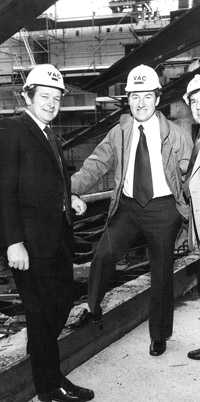
Recognising Lacy's interest in and commitment to education issues, Deputy Premier and Education Minister Lindsay Thompson invited Lacy to Chair his Parliamentary Party Committee on Education. This brought the two men closer together and Thompson performed a generous mentoring role with the young parliamentarian. It was a relationship over which Lacy agonised a few years later due to the criticism of Thompson that was implied from the substantial reforms in the administration of education in Victoria that Lacy was convinced he must pursue while in Cabinet.(Detail here: and here:) He became increasingly convinced and vocal that the government must restructure the administration of primary and secondary education in Victoria to a devolved school management system which empowered school communities, councils and principals who would obtain specialist support services from regional directorates. He tried, largely without success, to convince Thompson to have his ideas for educational reform, incorporated into the 1979 election policy, but otherwise he remained a great admirer of his mentor. After Rupert Hamer's resignation in 1981, he voted in the party room ballot for Thompson to be Premier - a ballot that Thompson won by one vote from Bill Borthwick. For ever after, Lacy was left to wonder what his career might have been had he not voted out of loyalty and the more electorally appealing Borthwick (for whom he also had great admiration) had led the Liberal Party to the 1982 election.
Lacy was prominent in defending Hamer's integrity and reputation in the Parliament against the attacks of the two renegade right wing Liberal MLAs, Charles Francis (Caulfield) and Doug Jennings (Westernport) and in September 1977 he successfully moved in the party room for their expulsion. He attacked the two members for their disloyalty to the Premier and their party colleagues by abstaining in a vote on an opposition no-confidence motion over Housing Commission of Victoria land deals. He argued that for an elected representative to abstain from voting was an abrogation of their principle responsibility upon which parliamentary democracy was based. He believed that MPs were primarily paid to vote, the record of which was democratically critical information for voters at subsequent elections. To abstain was a cowardly and devious means of keeping the electorate uninformed. His speech brought together the key tenents of his political and personal philosophy about which he was passionate - loyalty, transparency and accountability. He was strongly supported by the Speaker of the Legislative Assembly Sir Kenneth Wheeler and Community Welfare Services Minister Walter Jona[7][8]
Lacy represented the Victorian Parliament as a member of the Victorian Institute of Secondary Education Council from 1977 to 1979.[5] In 1977 he attended the 8 week Advanced Management Program at the Australian Administrative Staff College Mount Eliza on a scholarship he was awarded by the Parliament of Victoria. It was here that Lacy conceived and developed the general thrust of the decentralised regional and school based reforms that, with Education Minister Alan Hunt, he later introduced into the Victorian education system.[9]
Minister for the Arts (1979-1982)
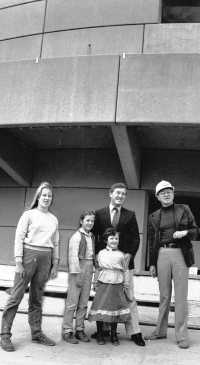
Lacy held the portfolio of Minister for the Arts from May 1979 to April 1982. During his Arts incumbency, he was responsible for the establishment of the Victorian Arts Centre Trust[10] and for the construction of the theatres, concert hall and spire of the Victorian Arts Centre.[11][12][13] During this period, Lacy's friendship with Peter Block was a most valuable resource. Block was a constant source of advice on many of the difficult issues that emerged in the critical construction phase of this major national project. Lacy was constantly called on to defend the Arts Centre Trust during some highly charged public debates in the Parliament. He had to defend the acoustics, the design of the spire, the rejection of the proposed changes to the Concert Hall interiors, the BASS ticketing system of the project, as well as its delays and cost over runs in debates that were often led by Opposition Leader John Cain.
In May 1980, prior to introducing the legislation to establish the management structure of the Victorian Arts Centre, he undertook a study trip with George Fairfax, the Centre's Executive Director to Los Angeles, San Francisco, New York, Washington, Toronto, Ottawa, London and Paris to assess administrative structures at major performing arts centres in these cities. However, Lacy's relationship with Fairfax deteriorated soon afterwards when he had to inform Fairfax that he could not support the additional cost and waste that would be involved in shelving the already acquired Concert Hall interior fittings and finishes in favour of new designs that the Trust had commissioned by John Truscott and was then actively promoting. Being responsible for both the generously funded Arts, and the over stretched Education, building programs created a moral tension for Lacy. Nor was he impressed with the Trust going over his head to directly lobby the Treasurer for the extra multi-million dollar funding required for the proposed new interiors. In the end, he won the argument with his long standing mentor and friend, Treasurer Lindsay Thompson and the Truscott designs were dropped.
In March 1981, Lacy had the Victorian College of the Arts[14] Act passed through the Victorian Parliament. Its purpose was the reconstitution of the Victorian College of the Arts (VCA) made necessary by the repeal in 1980 of the Victorian Institute of Colleges Act and to make it "better able to provide for the preparation of young people to enter upon careers as professional artists. It also represents a most significant development for the Victorian Arts Centre."[15][16]

In October 1981 Lacy created Film Victoria[25] as "a new statutory authority to be responsible for Government activities related to the production and distribution of film in Victoria including film for educational purposes".[26] The Act that he had passed through the Victorian Parliament provided for Film Victoria to be established by the amalgamation the Victorian Film Corporation (as it had been constituted initially in 1976), the State Film Centre and sections of the Audio Visual Resources Branch of the Education Department of Victoria.[27] The purpose of the amalgamation was to avoid the unnecessary duplication of functions by the three organisations; to enhance the capacity of the Government to meet the present and future media needs of Victorians; to simplify access to film materials and to enlarge the benefits to be derived from the use of such materials.[28] Lacy saw this initiative as supportive and complementary to his push to have the Australian Children's Television Foundation established.[29]
Other highlights of this period were:
- the acquisition of the property Heide II (in Bulleen east of Melbourne) and a collection of 113 art works from John and Sunday Reed in August 1980. Lacy's on-going support for this project saw the creation of a public art gallery, originally named Heide Park and Art Gallery, (but since 2006 as Heide Museum of Modern Art)[30] which was officially opened in November 1981.
- the development of a museum policy for Victoria and of a submission for a Museum of Social and Poltical History at the Old Treasury Building to the Executive Committee of Victoria's 150th Anniversary Celebrations in July 1981.
- the provision of funding for, and the opening on 8 December 1981, of the National Book Council of Australia's Book House in Carlton, Victoria.[31][32]
- the unveiling of the plaque on 13 August 1980 commemorating the centenary of the opening to the general public of the Exhibition Building on 29 May 1880.[33][34]
Assistant Minister of Education / Minister of Educational Services (1979-1982)
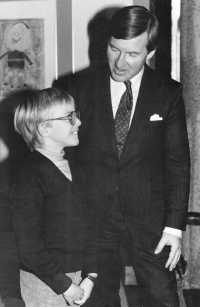
Together, Lacy (in the Legislative Assembly) and Hunt (in the Legislative Council) made a formidable team in the pursuit of their mission to reform the administration of the highly centralised Department of Education in Victoria.[35] As Assistant Minister of Education and later, Minister for Educational Services, Lacy was jointly responsible with Hunt for the most significant and far-reaching reorganisation of the Victorian Education Department in the 20th Century.[36][37]
Hunt appointed Lacy Chairman of the external Ministerial Consultative Committee that steered the project in its early phase and the Implementation Steering Committee later.[38] Lacy pulled together an impressive group of people from academia and business to assist him including Emeritus Professor Bill Walker from the University of New England who became a significant influence in Lacy's career after politics.[39]
Lacy's role in the Education portfolios included responsibility for the Special Services, the Building Operations and the Planning Services Divisions. He used this responsibility to initiate compulsory Physical Education in Schools.[40][41] For this, he was recognised in March 1983 by the award of a Fellowship by the Australian Council for Health, Physical Education and Recreation. Similarly, Lacy was responsible for the promotion of a reformed Health and Human Relations Education curriculum in Victorian Schools. He had been personally given this project by the Premier on being appointed to Cabinet after the 1979 election to fulfil a commitment Hamer had made prior to the election to the Women's Electoral Lobby. He pursued this mandate assiduously and against robust public opposition from rural based fundamentalist Christian groups as well as leading members of the Catholic Church and the National Civic Council. With the Premier's support he had the Principles and Policy Statements for Health and Human Relations Education approved by Cabinet on 15 October 1979 and the "Guidelines" and "Curriculum Statement" on 8 December 1981.[42]
His work in the planning, budgeting and delivery of the school building program gave the ex plumber some of his most satisfying experiences. He accepted every invitation he received to visit schools in Victoria. Usually, the purpose of the visit was to open a new school, library, art and craft centre or physical education facility. The latter being the subject of a carefully thought out plan - Education & Community Activity Centre (Ecacentre) program - which more efficiently expended the funds available for school assembly halls on a greater number of secondary schools for the purpose of providing a facility for indoor physical education and sport. He became enthusiastic about this program for many reasons not the least of which was that the design developed at his request by the Public Works Department was able to accommodate a regulation sized basketball court. He regarded this as his contribution to the growth of the sport that had given him so much structure and distraction during his teenage years. More than 200 secondary schools benefitted from the program that also provided the structural resources needed throughout the state to accommodate his compulsory physical education policy. Returning to Healesville High School in 1981 to officially open such a facility was one of the last highlights of Lacy's Ministerial career.
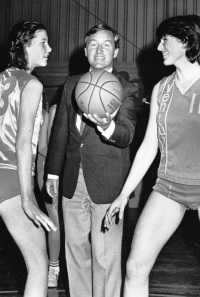
[43] He outlined his ambitious program in a speech he made at a seminar of Special Assistance Resource Teachers in December 1980. In it he announced the most significant development in remedial education in Victoria with a strategic plan for addressing a reported decline in literacy and numeracy skills amongst secondary students. The totally new component of the Special Assistance Program was the provision of 1000 Special Assistance Resource Teachers "in the delivery of services to children with special needs." They were given "a major on-site responsibility facilitating a productive relationship between parents and pupils and teachers."[44] The program involved the training of these primary teachers as Special Assistance Resource Teachers and their placement in schools. Their role was the early detection and remediation of children at risk of illiteracy and innumeracy.[45][46] Lacy's greatest political disappointment came from the Cain Labour Government's actions after their 1982 election directed at de-emphasising and largely dismantling this educationally highly significant and ground breaking program.
Lacy had a central role in the appointment of two departmental permanent heads in the Victorian public service during his Cabinet career. In 1980, he secured cabinet support for the appointment of Paul Clarkson, a former CRA executive, as Director of the Ministry for the Arts after the retirement of Dr Eric Westbrook the founding Director. Then in 1981, with Alan Hunt, he secured the replacement of Dr Laurie Shears as Director General of the newly restructured Education Department of Victoria by Toorak State College Principal Revd Dr Norman Curry.
During 1981, in the lead up to the 1982 election, Lacy worked assiduously on policy development. He developed policies on a number of issues within his portfolios. Almost every week during the spring session of Parliament in that year he delivered a ministerial statement in the Legislative Assembly on one of these policies in an attempt to counter the emerging mood for change in the electorate. With a solid margin, he had no expectation that he would lose his seat, but he was becoming increasingly convinced that the Government could not survive. Three disparate forces combined on election day in April 1982 to end his parliamentary career. Each of them related to a State-wide issue upon which he had publicly adopted a strong position. Smarting from the provision of a promised additional 1,000 teachers to the Special Assistance Program rather than to the reduction of student teacher ratios in classrooms, the Victorian Teachers Union vigorously targeted him. Right wing Christian groups and the DLP (with the direction of their preferences against him - the first Liberal to be so treated) targeted him over his Health and Human Relations Education program.[47] And the local Chambers of Commerce (made up of main street retailers) targeted him over his support for Sunday trading.
Management Educator (1982-1994)
Norman Lacy was separated from his first wife in January 1982 and was divorced in 1983. Being removed from his young family and then losing his seat in Parliament in April 1982 presented Lacy with the darkest period of his life since the death of his mother in 1956.[48] Living alone in The Avenue, Parkville in the neighbourhood of Ridley College where 20 years earlier he had commenced his theological studies, he wrestled with his loneliness and the loss of his family and career. It represented a personal crisis of identity, significance and purpose for which he had little support.
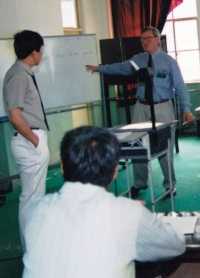
After parliament, Lacy developed a career in management education and consulting. At this time, he was greatly influenced by his reading on technological change in particular Barry Jones book Sleepers, Wake!.[49] In September 1982, he joined the Management Consulting Services division of Deloitte, Haskins and Sells, one of the 'big five' chartered accounting firms. Soon afterwards, in April 1983 he bought a home in Camberwell, Victoria and moved in.
In October 1983, with the support of the firm, he took leave to study full-time at Durham Business School at Durham University in the north east of the United Kingdom. While at Durham, he was elected by his fellow students to the Board of Studies of the School. He used the position to encourage the School to establish the first information technology course for M.Sc (Management) students. His masters dissertation was on "the perceptions of information technology professionals, their understanding of managerial decision-making and the role of the decision support system designer".[50] He graduated as Master of Science (M.Sc.Management) in 1984. After returning to Australia from Durham, Lacy was appointed Manager, Corporate Communications at the new joint venture IBIS DH&S Australia.
In June 1985, Lacy married his second wife with whom he had a son in 1998.
Soon afterwards, at the invitation of Professor Bill Walker, Lacy was appointed a Member of the Directing Staff (1985–91), and subsequently Director, International Programs (1988–91), at the Australian Management College, Mount Eliza. During the 1st 3 years of this period, he and his wife lived at 26 Bambra Street, Mount Eliza after which they moved back to their home in Camberwell. In 1988, the college invited him to attend the internationally renowned Leadership Development Program at the Center for Creative Leadership at Greensboro, North Carolina, USA to assess the program and to be trained there to deliver it under license in Australia. During the following 3 years he delivered the 6-day program at Mount Eliza on more than 24 occasions to approximately 600 Australian middle and senior level managers.[51]
In 1990, the college appointed him to lead a team of 20 staff as Director of the China-Australia Management Centre that was established near Beijing, China. The establishment of the Centre was an Australian Government aid project in association with the Australian Management College, ACIL Australia and the China National Non-Ferrous Metals Industry Corporation (CNNC). During Lacy's tenure, the centre (based at a CNNC university at Yan Jao), where he and his wife lived from 1991 to 1994, trained 1,500 Chinese senior and middle level managers from mines, processing and manufacturing plants throughout China. The centre - whose mission was to train CNNC managers in western management theory and practice - was one of two that had been promised to the Chinese Premier Zhao Ziyang by Australian Prime Minister Bob Hawke on a visit to China in 1983. The other, in the iron and steel industry, was located at Wuhan.
IT Industry Executive (1994-2009)
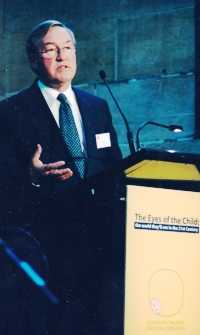
From 1998-2000 he was Managing Director, of The Swish Group Limited.[53] The position involved the establishment of the company during 1998, firstly as a consultant, and then from December 1998 as Managing Director. The Swish Group was one of the early Internet Service Providers in Australia, focusing on website, touch screen kiosk and CD-ROM design, e-commerce solutions and hosting. His achievements in this position included the formation and integration of the company by the acquisition and merging of three companies, and its Initial Public Offer and successful listing on the ASX. In July 1999 he was invited to represent small business in the ICT industry on the Australia Israel Chamber of Commerce IT&T Trade Mission to Israel, led by the Minister for Communications IT and the Arts, Richard Alston.
From 2000 to 2009, Lacy was the founding Executive Director of the Information Technology Contract & Recruitment Association.[54] This role required the establishment of the Association, the development of its products and services and the ongoing management of its membership and revenue growth. During this period, ITCRA’s membership grew from 6 to more than 150 companies across Australia and New Zealand.[55] Lacy's other achievements in this position included the establishment of a national research project at the invitation of the Department of Communications, IT and the Arts in May 2006. SkillsMatch ICT Labour Market Analysis is an on-line consolidated national database that addresses the need for labour market participants to gain an informed understanding of the ICT skills market and future skills demand. With Tower Life Australia in April 2001, he established the IT Super superannuation fund. The establishment and growth of IT2 as the second most successful IT job board, in partnership with SEEK (2002–2005) and with Fairfax Digital (from 2005) was a significant achievement. As was the design, establishment and growth of the ITCRA Certified Recruitment Professional program.
Having become an independent contractor in 1991, in early 2000 Norman Lacy joined the Board of Independent Contractors Australia[1] He has been President since October 1998. During this period he has worked on ICA's policy development and lobbying campaigns that have focused on:
- the introduction of the Personal Services Income (Tax) Act;[56][57][58] (2000-2001)
- participation in the International Labour Organisation (ILO) debates regarding the Scope of the Employment Relationship resulting in a 2006 ILO Recommendation protecting the legitimacy of independent contractors and the commercial contract. (2003–6)
- the introduction of the Independent Contractors' Act (2006).[59][60][61] (2005–6)
- the establishment of small business commissioners in each state and territory and in the Commonwealth Government (2007-2011).
- the development and promotion of Charter of Contractual Fairness[62] to governments and corporations and to have the Trade Practices Act amended to extend the protections for contractual fairness, available to consumers, to small businesses. (2009-12)
Lacy has held a number of memberships in a variety of national organisations during that time, including:
- Fellow, Australian Council for Health, Physical Education and Recreation;
- Associate Fellow, Australian Institute of Management;
- Member, Australian Institute of Company Directors;
- Associate Member, Australian Computer Society;
- Member of the ICT Sector Advisory Committee of Innovation and Business Skills Australia (IBSA) (2005–2009);
- Member of the ICT Skills Foresighting Working Group at the invitation of the Commonwealth Minister for Communications, IT and the Arts, Helen Coonan (2004–2006);[63]
- Member of the Information and Communications Technology Advisory Group at the invitation of the Victorian Minister for State and Regional Development, John Brumby (2001);[64]
- Chairman of the Board of IT Super(2002–2009);
- Member of the Board of Independent Contractors Australia[65] since 2000, and President since November 2008.
References
- ↑ 1.0 1.1 ICA website
- ↑ Pamela Bone, Up We Grew: stories of Australian childhoods, Melbourne University Press, 2006
- ↑ Ridley College website
- ↑ Australian College of Theology website
- ↑ 5.0 5.1 5.2 5.3 "Lacy, Norman Henry". re-member. Parliament of Victoria. Retrieved 24 August 2008.
- ↑ Barry Jones, A Thinking Reed, Allen & Unwin, 2006.
- ↑ Minutes of the Victorian Parliamentary Liberal Party September 1977
- ↑ Walter Jona, People, Parliament and Politics, Tertiary Press, 2006, p 178
- ↑ Murray Landt - Past VPPA President
- ↑ Victorian Arts Centre Bill Explanatory Second Reading Speech by the Hon. Norman Lacy MP Minister of the Arts in the Legislative Assembly on 21 November 1979
- ↑ Victorian Arts Centre website
- ↑ Victorian Arts Report 1979-1980 7th Annual Report Victorian Council of the Arts and Victorian Ministry of the Arts, Government Printer, page 8
- ↑ Vicki Fairfax, The Place Across the River: The Story of the Building of the Victorian Arts Centre, Macmillan, 2001,
- ↑ Victorian College of the Arts website
- ↑ The Victorian College of the Arts Bill Explanatory Second Reading Speech by the Hon. Norman Lacy, M.P. Minister for the Arts in the Legislative Assembly of the Parliament of Victoria on 19 March 1981.
- ↑ The Victorian College of the Arts Bill Explanatory Second Reading Speech ibid Lacy laid out a rationale for the re-constitution of the College under a VCA specific Act which was derived firstly "from the quite specific demands and circumstances of preparing young artists for professional practise." He asserted that "the basic concept upon which the college is built is that young artists intending to enter careers as practitioners in their various fields are best assisted to achieve their ambitions in a milieu of continuous artistic activity and endeavour of a fully professional nature. To the extent that artistic education is separated from normal professional practice it is so much less effective." Secondly, the rationale related to the adjacent location of the VCA campus to the National Gallery of Victoria and the Victorian Arts Centre. He said that this "Greater Arts Centre concept is central to the Government's decision to reconstitute the college by separate statute as well as to the development of the arts in general. It represents a simple, readily achievable and highly effective means of creating a substantial milieu of continuous professional activity of the highest standards. It also has ramifications which extend far beyond the college and its partner institutions. Its implementation will shape and invigorate the arts in many ways and lead to a dynamic, cultural and social facility without peer in Australia" and that it "afforded an unparalleled opportunity and challenge to present total programmes in the arts which should encourage creative exchanges between the art forms, give inspiration to students of the arts and provide for the public an experience which few places in the world can match." The Government therefore believed that the VCA's role was substantially different from other educational institutions.
- ↑ The Age, 25 June 1981
- ↑ Andrew Spaull, A History of the Australian Education Council 1936-1986, Allen & Unwin, 1987, pp 285-288
- ↑ Australian Children's Television Foundation Annual Report 2001-2002, page 16 - The Hon Norman Lacy, former Victorian Minister for the Arts and Educational Services at the ACTF's 20th Anniversary Symposium - "The Eyes of the Child:The World They’ll See in the 21st Century", 20 March 2002 at The Chapter House, St Paul’s Cathedral, in Melbourne, Victoria, "There are not a lot of events in my career about which I look back on with a deep sense of satisfaction. But amongst the most satisfying of them is the moment when I took the punt and asked Dr Edgar to come and work for me half time in a ‘dingy little office with its stingy ray of sunlight’ on Exhibition St, here in Melbourne and to begin working on turning her vision into a reality. And the rest as they say is history. But what a rich history of achievement in ‘caring for kids’ it has been."
- ↑ Patricia Edgar, Bloodbath: A Memoir of Australian Television, Melbourne University Press, 2006
- ↑ 'The Art of Getting Things Done' by Patricia Edgar in Share Visions - Women in Television, Annette Blonski and Hilary Glow Eds. Australian Film Commission 1999 page 30 "Norman Lacy, the Victorian Minister for the Arts and Education, happened to read a paper I’d given for the annual Grierson Lecture in which I had proposed the establishment of a foundation for children’s television. He asked me to see him because he said he liked the idea and I and others set about gathering support. Lacy took the idea to the AEC (the Council of Ministers of Education). After long and extensive lobbying of State governments and Canberra politicians, we succeeded."
- ↑ Senate Legislative and General Purpose Standing Committees The First 20 Years (1970-1990) - Employment Education and Training
- ↑ Australian Children's Television Foundation website
- ↑ Andrew Spaull ibid
- ↑ Film Victoria website
- ↑ The Second Reading Speech on the Film Victoria Bill presented to the Legislative Assembly of the Parliament of Victoria by the Hon. Norman Lacy M.P. Minister for the Arts and Minister of Educational Services, 6 October 1981
- ↑ ibid page 2. "Over the last few years the view has been expressed that the quality of educational television should be improved, that local production initiatives should be encouraged and that distribution services should be rationalised. This has been evident in official enquiries into the granting of broadcast licenses, at ministerial conferences and in published reports. In response I set up the Interim Board for Educational Film and Television in April 1980. .... The views of the Interim Board have been conveyed to me through numerous progress reports and have been influential in developing the concept of Film Victoria. .... another substantial influence on this Bill was my visit last year to the Children's Television Workshop in New York and the Ontario Educational Communications Corporation in Toronto."
- ↑ ibid page 2
- ↑ ibid page 7. "Preliminary steps have been taken ..... to develop high quality television programs for children. With the passage of this Bill, Victoria will be in a better position to continue these developments, to link in with initiatives which may be undertaken by the proposed Australian Children's Television Foundation and to tap into the resources of the private sector of the film and television industry. I would expect Film Victoria to take up the challenge to produce good children's drama for commercial television and to fill the present void in this area of children's television programming."
- ↑ Heide Museum of Modern Art website
- ↑
- ↑ The Hon. Mr. Justice Micheal Kirby, National Book Council Annual Report, January 1982,page 1-2 "Book House is an exhilarating project. Probably the happiest occasion of the year was the opening by the Honourable Norman Lacy MP, Victorian Minister for the Arts, of Book House, Melbourne on 8 December 1981. Mr. Lacy was introduced to a representative cross section of people involved in the world of books in Australia by our Chairman, Dr. Stephen Murray-Smith. Without the support of the Victorian Government, and the interest of the Minister, this novel enterprise would not have been possible. Mr. Lacy was a minister of religion, before, he became a Minister of the Crown in 1979. The precedent for this transfer were not suspicious, St. Thomas á Becket and Cardinal Wolsey being two precursors who sprang to my mind."
- ↑ Photograph of Plaque on Museum of Victoria website
- ↑ Photograph of Unveiling of Plaque on Museum of Victoria website
- ↑ Murray Landt - Past President Victorian Primary Principals Association - "The years 1980 and 1981 were very significant years in the history of state education in Victoria. For the first time in eighty years there was a complete restructure of the Education Department. Minister Norman Lacy whilst attending a two month course at the Australian Administrative Staff College at Mount Eliza devised a model in which the Director-General was replaced by a group of managers. The Government legislated, at the end of 1981, to scrap the teaching divisions (Primary, Secondary and Technical) and to remove the statutory bodies (The Committee of Classifiers and the Teachers’ Tribunal). ...a firm of business consultants (P.A. Australia) was used to implement the Government's plans."
- ↑ Alan Hunt and Norman Lacy, Strategies and Structures for Education in Victoria, Victorian Government Printer, 1980
- ↑ M Frazer, J Dunstan, P Creed Eds., "Implementing Change" in Perspectives on Organisational Change, Longmans, 1985
- ↑ Education (Amendment) Bill Explanatory Second Reading Speech by The Hon. Norman Lacy MP Minister of Educational Services in the Legislative Assembly on 10 September 1981
- ↑ Aims and Objectives of Education in Victoria Ministerial Statement by The Hon A.J.Hunt MLC Minister of Education in the Legislative Council and The Hon Norman Lacy MP Assistant Minister of Education in the Legislative Assembly on 12 December 1979
- ↑ The Age, 21 January 1981
- ↑ New Directions in Physical Education A Ministerial Statement by The Hon. Norman Lacy MP Minister of Educational Services in the Legislative Assembly on 17 September 1981
- ↑ Health and Human Relations Education Education Department of Victoria 15 March 1982
- ↑ Letters to the Editor, The Age, 10 July 1980
- ↑ a speech by the Hon. Norman Lacy MP, Assistant Minister of Education at the Opening of the Seminar of Special Assistance Resource Teachers at the Hawthorn State College on 15 December 1980
- ↑ The Special Assistance Program A Ministerial Statement on New Directions in Literacy and Numeracy by the Hon. Norman Lacy MP Minister of Educational Services in the Legislative Assembly on 9 September 1981
- ↑ The Hon. Mr. Justice Micheal Kirby, ibid, "But there is no doubt that the Minister has used his public office to good effect in ensuring support (including financial support) for the establishment of Book House in Melbourne. He has taken a special interest in the problem of illiteracy and the remedial teaching of English. In his department, he is known as the 'Minister for Reading'. Personally, I can think of no prouder title for an Australian Minister to hold."
- ↑ The Age, 4 March 1985
- ↑ Pamela Bone ibid
- ↑ Barry Jones, Sleepers, Wake!: Technology and the Future of Work, Oxford University Press, 1982
- ↑ The Role of the DSS Designer: A Study of Computer Industry and Public Sector Perceptions, by Norman Lacy, Dissertation submitted as part requirement for the degree of Master of Science in Management Studies of Durham University Business School, 1984
- ↑ Norman Lacy, "Leadership in Australia" in The Practising Manager, July 1990
- ↑ Australian Computer Society
- ↑ The Swish Group Limited
- ↑ ITCRA, Information Technology Contract & Recruitment Association
- ↑ President's Report 2007-2008, Information Technology Contract & Recruitment Association, 19 August 2008
- ↑ Income tax: the meaning of personal services income
- ↑ Australian Financial Review, Plea for Leniency on Contractors, "The Howard Government may be forced to accept a lower revenue yield from its planned crackdown on contractors, prompting industry to lobby senior ministers for a more sympathetic contractor test." 24 March 2000
- ↑ Australian Financial Review, ATO unreasonably rejects travel claims of IT contractors, 7 August 2012
- ↑ ABC transcript from The World Today, Government Introduces Independent Contractors Bill to Parliament, 22 June 2006
- ↑ Independent Contractors Act 2006
- ↑ O'Malley Nick, Workplace Reporter, New Law Threatens Pay Rights of Workers, Sydney Morning Herald, June 23, 2006
- ↑ Charter of Contractual Fairness
- ↑ Department of Communications IT and the Arts, Building Australian ICT Skills - Report of the ICT Skills Foresighting Working Group, Commonwealth of Australia, May 2006, page 60
- ↑ Media Release from The Hon John Brumby, Minister for State and Regional Development Advisory Group to Help Shape ICT Industry Plan, Tuesday, 22 May 2001
- ↑ ICA brochure
Sources
- Andrew Spaull, A History of the Australian Education Council 1936-1986, Allen & Unwin, 1987;
- Conversations with the subject from 23 August 2008 - 5 September 2011;
- G Browne, Biographical Register of the Victorian Parliament 1900-84, 1985;
- Addressing Declining Literacy and Numeracy Skills in Victorian Primary Schools, The Internet Archive, 13 July 2012;
- M Frazer, J Dunstan, P Creed Eds., "Implementing Change" in Perspectives on Organisational Change, Longmans, 1985;
- Norman Lacy, “Community Education - Another Perspective” in Community, Participation and Learning, J. Bremmer, I. Bennett, D. Kiers, J. Liard, Eds., AACE, 1980;
- Notable Australians, Melbourne, 1978;
- Pamela Bone, Up We Grew: Stories of Australian Childhoods, Melbourne University Press, 2006;
- Parliament of Victoria Registary, February 2008;
- Patricia Edgar, Bloodbath: A Memoir of Australian Television, Melbourne University Press, 2006;
- The Age, 17 May 1979, 5 Apr 1982;
- The Herald, 16 Oct 1982;
- Vicki Fairfax, The Place Across the River: The Story of the Building of the Victorian Arts Centre, Macmillan, 2001;
- Victorian Parliamentary Handbook;
- Walter Jona, People, Parliament and Politics, Tertiary Press, 2006;
- Who's Who in Australia 1974-1980;
|